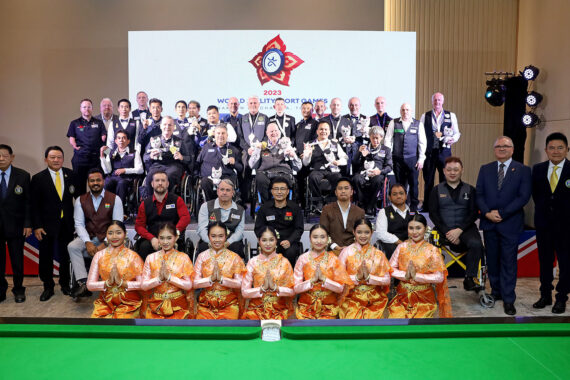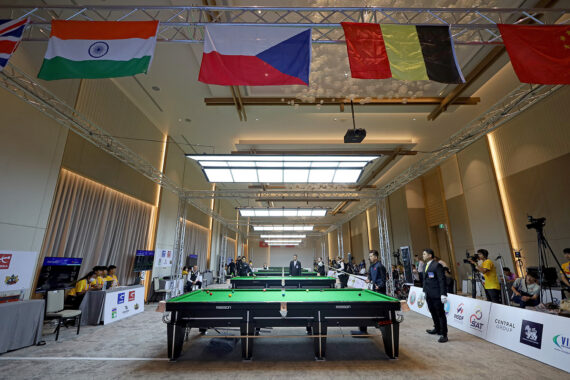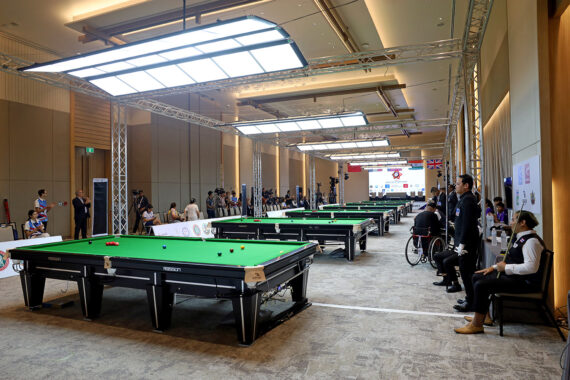WDBS Winners To Receive Medals In York
Entries are still open for the first tournament staged by the new World Disability Billiards and Snooker body in Gloucester later this month, and the WDBS is delighted to announce that the winners will be invited to one of snooker’s biggest events to receive their medals.
The medals will be presented at the York Barbican on Saturday December 5th during the final weekend of the Betway UK Championship. Each winner will also receive two tickets for the afternoon and evening sessions and a hotel room.
The WDBS event will run on the weekend of November 28-29 at the South West Snooker Academy – for full details and the entry pack CLICK HERE
The profiles below show who can play in this event. WDBS is looking to run tournaments for Groups 6 (learning disabilities), 7 (visual impairment) and 8 (deaf/hearing impairment) in the future and we would be interested in contact (chris.hornby@worldsnooker.com) from any groups or leagues which already provide provision for these groups.
Wheelchair profiles
Profile 01: Almost no use in four limbs. Need to use a power wheelchair, or be pushed in a manual wheelchair.
Profile 02: Almost no use in four limbs, but can bend elbows, and just about push a manual wheelchair. May need to use a power wheelchair.
Profile 03: Wheelchair user with very poor balance and inability to grip and release objects.
Profile 04: A person with almost no use in any limb, but with good trunk control. Usually able to push a wheelchair in some way.
Profile 05: A wheelchair user who has difficulty controlling their limbs when trying to perform any activity.
Profile 06: A wheelchair user with poor trunk control and slightly weak hands, or slight lack of control in arms.
Profile 07: A wheelchair user with good use in only one arm, they may need to use a power wheelchair if unable to push manual wheelchair.
Profile 08: A wheelchair user with good control of trunk and slightly weak hands.
Profile 09: A wheelchair user with good use in arms, but with poor trunk control.
Profile 10: A wheelchair user with good use of trunk and arms but unable to use the hips to assist trunk movement.
Profile 11: A wheelchair user with good control of trunk and hips
Ambulant Profiles
Profile 12: Able to walk, but has severe difficulty controlling all four limbs when performing an activity. May need to use a support to walk, or may have severe deformity of four limbs.
Profile 13: Able to walk, but has poor use of three limbs, usually uses a stick in good hand.
Profile 14: Able to walk, but one side of the body is of little use; usually can only balance unaided on the good leg.
Profile 15: Able to walk, but only one side of body works correctly.
Profile 16: One upper limb has little or no use.
Profile 17: Able to walk, but both legs are severely impaired, acting more like props. May need support to walk.
Profile 18: Able to walk, but one leg severely impaired, like a prop; other leg normal.
Profile 19: Able to walk, one leg severely impaired, used like a prop; other leg less impaired.
Profile 20: Able to walk and run but both legs impaired slightly – e.g. a moderate to slight diplegic.
Profile 21: Both arms are severely impaired or may be absent.
Profile 22: Both arms slightly impaired or absent below the elbow.
Profile 23: One leg has slight impairment, and they can usually run if fit enough.
Profile 24: One arm demonstrates difficulty with activities or below elbow amputee.
Profile 25: Very short stature (at least 12 inches (30.5cm) shorter than average, in particular extreme shortness of limbs.
Profile 26: Impairment of all four limbs, but not as severe as profile 12.
Profile 27: Opposite arm and leg severely impaired.
Profile 28: Both hips impaired causing walking difficulty, usually waddling gait.
Profile 29: Both shoulders causing problems with movement
Profile 30: Deformity or weakness of the trunk.
Profile 31: Both legs severely impaired, both arms moderately impaired.
Profile 32: Both arms severely impaired, both legs moderately impaired.



